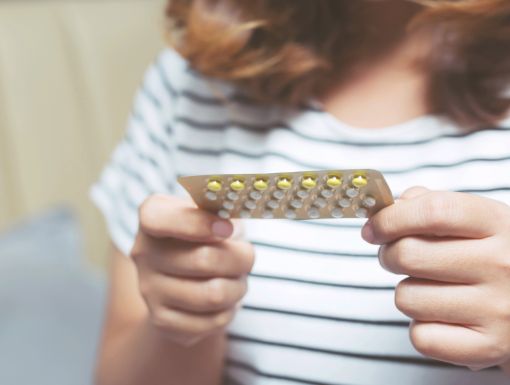
What Birth Control Method is Right for Me?
Making the choice to get on birth control can be easy. Choosing which method is right for you, not so much. There many types of birth control, with effectiveness rates ranging from 70% to 100%. You need to find the method that will prevent an unintended pregnancy but will also fit your lifestyle.
The Pill
Birth control pills are one of the simplest and most common contraception methods. The hormones in the pills prevent ovulation, which stops the ovaries from releasing an egg. Pills can be progestin-only or a combination pill of progestin and estrogen. These hormones also thicken the mucus in the cervix, which also stops sperm from entering the uterus and potentially fertilizing an egg.
- Effectiveness rate:99% if used correctly. However, most women might forget to take a pill or forget to take it at the same time every day, which can lower the effectiveness rate by up to 92%. Condoms are recommended with this method for extra pregnancy prevention and to protect against STIs.
- Pros: Affordable ($0-$50), easy-to-use, effective if taken correctly, helps with acne, eases menstrual cramps and bleeding, and can help prevent cancer in ovaries. You can get pregnant after stopping pills.
- Cons: Must take daily, does not protect against STIs, may cause nausea, weight gain, sore breasts, changes in sex drive, may cause spotting, must be taken consistently for seven days to start being effective.
- Recommended for: Women who are extremely organized and have no problems taking pills daily.
Intrauterine Device (IUD)
An IUD is a small device that is inserted into your uterus. It is made from flexible plastic and has a T shape. There are two different kinds of IUDs: copper (ParaGard) and hormonal (Mirena, Skyla, Kyleena and Liletta). A copper IUD has copper wiring that coils around the plastic. The copper acts as sperm repellent. which prevent the sperm from reaching the egg. This type of IUD can last up to 12 years. A hormonal IUD releases progestin (much like the pill), which thicken the mucus in the cervix and also prevents ovulation.
To insert the IUD, a doctor will use a speculum in the vagina and use the inserter to put the device through the opening of the cervix and inside the uterus. These types of IUDs can last between three and seven years, depending on the brand you choose.
- Effectiveness rate:99%. Condoms are recommended with this method to protect against STIs.
- Pros: Very effective, no daily action required and can last years. You can become pregnant right after removal. Additionally, hormonal IUDs may ease menstrual cramps and bleeding. A copper IUD can also be used as emergency contraception if placed within five days after unprotected sex.
- Cons: Must be placed by a doctor, price can vary up to $1,300, does not protect against STIs and slight pain during and a couple of days after placement. Copper IUDs can cause heavier menstrual cramps and bleeding and spotting.
- Recommended for: Women who are not planning on having children or are not planning on having children for an extended period. Also, beneficial if you are not good at daily or monthly contraceptive methods.
Implant
The implant (Nexplanon) is a small, thin and flexible plastic rod the size of a matchstick that is inserted into the upper arm. The implant releases the hormone progestin, which causes the cervical mucus to thicken and stop the sperm from reaching the egg. This hormone can also prevent ovulation. This form of birth control can last between three and five years. The doctor will give a shot to numb the area. The implant comes loaded in an applicator with an open-bore needle that goes through the skin to deploy the implant into the designated area. To remove the implant, your doctor will make a simple incision and pull the implant out.
- Effectiveness rate: 99%. Condoms are recommended with this method to protect against STIs.
- Pros: Very effective, no daily action required, long-lasting and feels barely there. You can become pregnant right after removal. It also can decrease menstrual cramps
- Cons: Must be placed by a doctor, price can vary up to $1,300, does not protect against STIs, irregular bleeding the first six to 12 months, pain at site of the insertion for a couple of days after, and implant might move from insertion site.
- Recommended for: Women who are not planning on having children for a shorter period of time. Also, beneficial if you are not good at daily or monthly contraceptive methods.
The Shot
Depo-Provera is the birth control shot you get once every three months. The shot contains the progestin hormone, which stops ovulation and thickens the cervical mucus. This form of birth control requires a doctor’s visit four times a year. It’s important to make the appointments and then stick to them.
- Effectiveness rate: 94%. Condoms are recommended with this method for extra unintended pregnancy prevention and to protect against STIs.
- Pros: Effective, no daily action required, less expensive than an IUD ($0-$150), can decrease periods, and can help prevent cancer in the uterus.
- Cons: Requires doctor’s visit four times a year, shot works only if you get it on time, and may cause heavier periods or spotting. Side effects include nausea, weight gain, breast soreness, depression, hair and skin changes and change in sex drive. It does not protect against STIs, and it may take up to 10 months to become pregnant after discontinuing the shot.
- Recommended for: Women who want a more discrete and noninvasive birth control option. Also good for women who are great at scheduling and keeping appointments.
The Vaginal Ring
The vaginal ring (NuvaRing) is small, flexible, plastic ring that is placed inside the vagina. The ring contains the progestin and estrogen hormones, which are absorbed through the vaginal lining. The hormones prevent ovulation and thicken cervix’s mucus which will stop the sperm from reaching the egg. The ring must be inserted into the vagina for three weeks and then be taking out, while your menstrual cycle begins. Once your cycle has finished you must insert a new vaginal ring for the next three weeks. However, you can also use the vaginal ring to safely skip a period if needed. Instead of wearing the ring for three weeks, wear it for four and change to a new ring the following week.
- Effectiveness rate:91%. Condoms are recommended with this method for extra unintended pregnancy prevention and to protect against STIs.
- Pros: Effective, no daily action required, less expensive than an IUD ($0-$200), doctor’s visit not required, makes periods more regular and lighter, can use rings to safely skip a period, helps with acne and premenstrual syndrome, can get pregnant after discontinuing use.
- Cons: You need to remember to change the ring on time, changes in sex drive, nausea, headaches and breast soreness.
- Recommended for: Women who are looking a cost-effective method that doesn’t require daily action and multiple doctor’s visits.
The Patch
The birth control patch (Xulane) is a contraceptive that is placed on the skin like a Band-Aid. The patch contains the progestin and estrogen hormones which are absorbed through your skin. For this reason, the patch must be worn on specific parts of the body such as the stomach, back, upper arm or butt. The estrogen and progestin hormones will prevent ovulation and thicken the mucus on your cervix. Like the vaginal ring, the patch must be worn for three weeks. However, the patch must be changed every week. On the fourth week, you take the patch off as your period will start. Once your period is done, you must go back to wearing the patch for the next three weeks.
- Effectiveness rate: 91%. Condoms are recommended with this method for extra unintended pregnancy prevention and to protect against STIs.
- Pros: Effective, no daily action required, less expensive than an IUD ($0-$150), doctor’s visit not required, makes periods more regular and lighter, helps with acne, can be worn in the shower, can get pregnant after discontinuing use.
- Cons: You need to remember to change the patch every single week, must use new patch if it becomes loose or falls, can cause changes in sex drive, nausea, headaches and breast soreness.
- Recommended for: Women who are looking for a cost-effective method that doesn’t require daily action and multiple doctor’s visit. Good for women who are great at scheduling weekly reminders.
Male Condom
The male condom is one of the most recognized forms of birth control. It is a thin casing that goes over the penis and can be made from latex, polyurethane or lambskin. The condom prevents the semen from entering the vagina. Condoms are also beneficial in that they protect against STIs by limiting the exchange of bodily fluids that can spread infections. It’s important to note that lambskin condoms do not provide the same STI protection. This is because lambskin condoms have pores that are small enough to block sperm but not small enough for viruses to pass through. Male condoms must be used every single sexual interaction and placed correctly to be effective.
- Effectiveness rate: 85%. Condoms are recommended to be paired with other types of birth control methods for extra unintended pregnancy prevention and to protect against STIs.
- Pros: Effective, inexpensive ($2 per condom), easily accessible, protects against STIs, non-hormonal method.
- Cons: A new condom must be used every single time you have sex, does not provide constant protection, condoms can break or slip, both parties must agree to use a condom.
- Recommended for: Women who are looking for a cost-effective method and for added protection against unintended pregnancy and STIs.
Internal Condom
Internal condoms, formerly known as “female condoms,” are thin plastic casings with a flexible ring at each end. These condoms can go inside the vagina or anus. One end of the condom is inserted into the vagina or anus while the other end remains on outside. Just like regular male condoms, internal condoms provide STI protection. The internal condom prevents sperm from reaching the egg by creating a barrier in the inside of the vagina. It is extremely important to know that an internal and male condom should not be used at the same time as a means of double protection. The friction between the two condoms could result in them breaking.
- Effectiveness rate:79%. The internal condom is recommended to be paired with other types of birth control methods (except male condoms) for extra unintended pregnancy prevention and to protect against STIs.
- Pros: Effective, inexpensive ($3 per condom), protects against STIs, latex-free, non-hormonal method, internal condoms give women more control over sexual health versus a male condom.
- Cons: A new condom must be used every single time you have sex, does not provide constant protection, may need prescription, condoms can break or slip, may take some getting used to.
- Recommended for: Women who are looking for a cost-effective method, protection against unintended pregnancy and STIs and the ability to choose to wear a condom.
Fertility Awareness
Fertility awareness or natural family planning is a birth control method that tracks your ovulation. Tracking your menstrual cycle will help you calculate your ovulation window. This is the period in which one of the ovaries releases an egg meaning that you are most fertile. Women can choose to abstain from sex or use short term birth control methods like condoms during this window.
- Effectiveness rate: 76%. Condoms must be used during fertile days and to protect against STIs.
- Pros: no cost, non-hormonal method, no side-effects .
- Cons: Semi-effective, requires serious dedication and planning, does not provide constant protection.
- Recommended for: Women who have birth control set on a low priority.
Abstinence
Abstinence is known as the act of refraining from sexual activity. By abstaining from sex, you are preventing the exchange of bodily fluids. This means semen doesn’t have the chance to enter the vagina and reach the egg. Abstinence is the only form of birth control that is a 100% effective and protects against STIs. However, it does require dedication and will power.
- Effectiveness rate: 100%.
- Pros: No cost, non-hormonal method, no side-effects, protects against STIs.
- Cons: Requires serious dedication and willpower.
- Recommended for: Women who want a birth control method that is 100% effective and are not looking to get into a sexual relationship.
Tubal Ligation/Vasectomy
A tubal ligation or “getting your tubes tied” is a surgical sterilization procedure in which the fallopian tubes are cut, sealed or tied. A vasectomy is the male version of sterilization in which the vas deferens tube in the scrotum is cut. This will keep the sperm out of the semen. Eventually, any remaining sperm will be absorbed into the body and after three months there will no longer be any sperm in the semen. Both procedures are quick and simple, but they are not reversible.
- Effectiveness rate: 99%. Condoms are recommended with this method to protect against STIs.
- Pros: Very effective, permanent, non-hormonal method, low-maintenance.
- Cons: Non-reversible, price can vary vasectomy ($1,000) or tubal ligation ($6,000), does not protect against STIs, some pain during and a couple of days after procedure.
- Recommended for: People who are sure they do not want to have children.



